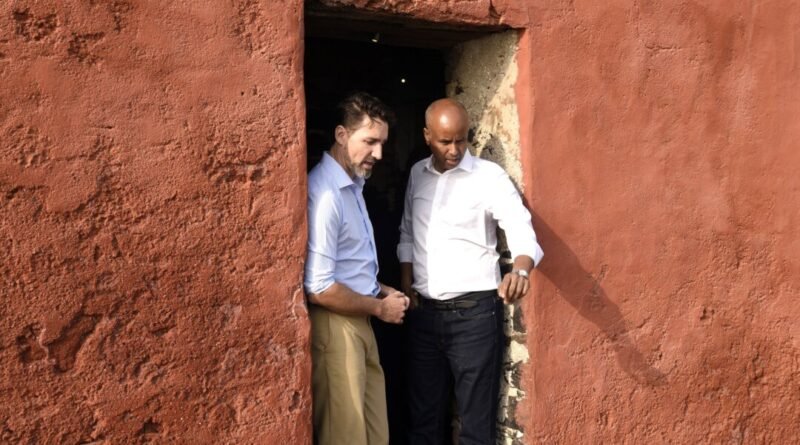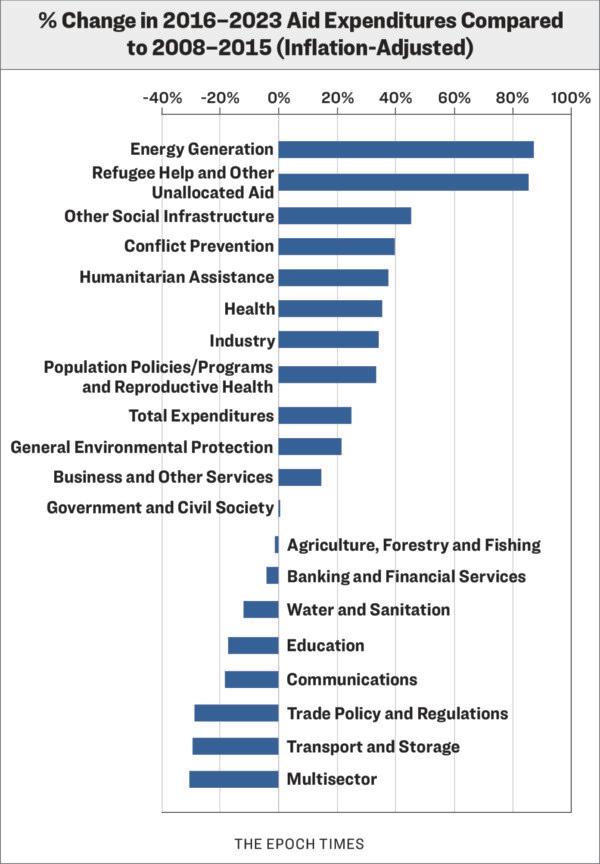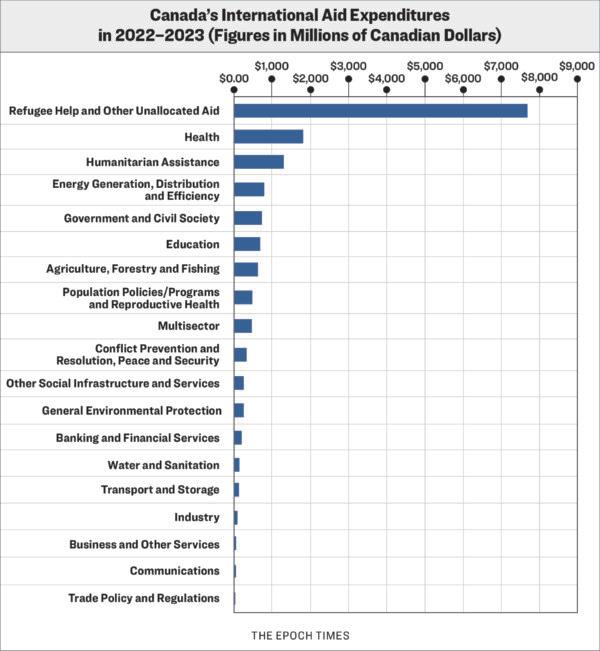How is Canada’s $16 Billion in Foreign Aid Utilized Annually?
An analysis by The Epoch Times shows inflation-adjusted foreign aid expenditures have increased by 25 percent since the Liberals came to power for the period of time between 2015 to 2023, compared to an equivalent number of years during the previous Conservative government.
This marks an increase of $13.8 billion when comparing the $55.9 billion spent between 2008 and 2015 to the $69.7 billion spent between 2015 and 2023, all in 2023 dollars.
Canada’s top-three aid expenditures each year have been in the areas of refugee and asylum seeker settlements, global health, and humanitarian assistance.
The aid figures also exclude military-type interventions. For context, Canada has contributed $13.3 billion to Ukraine alone for military and other aids since the start of the war there in 2022.
Changes Under Current Government
According to an Epoch Times’ analysis, the aid sectors that have seen the largest percentage change in inflation-adjusted funding since the Liberals took power have been in energy generation (led by renewables) with an 87 percent increase, refugee settlement with 85 percent (jump driven by Ukraine war, though even before that the amount had increased), and social infrastructure at 45 percent.
Other sectors that saw a rise under the Liberal government are conflict prevention (40 percent), humanitarian assistance (37 percent), health (35 percent), industry (34 percent), population policies/programs and reproductive health (33 percent), general environmental protection (21 percent), business and other services (14 percent), and government and civil society (less than 1 percent).
Areas that have had a negative percentage change in spending in the Trudeau years include multi-sector aid which involves areas such as research institutions and urban and rural developments (-30 percent), transport and storage (-29 percent), trade policy and regulations (-28 percent), communications (-18 percent), education (-17 percent), water and sanitation (-12 percent), banking and financial services (-4 percent), and agriculture, forestry, and fishing (-1 percent).
In Dollars
In 2022-2023, Canada sent $1.78 billion for health expenditures and $1.29 billion in humanitarian assistance internationally.
About $786 million was spent in energy generation, distribution, and efficiency in the same year. As Canada’s climate change policy investments increase, aid in renewable generation and other areas related to climate change policies are expected to experience a sharper rise in the coming years.
Aid in government and civil society in 2022-2023 was at $730 million, in education at $681 million, and agriculture, forestry, and fishing at $625 million.
Aid in the multi-sector category, involving areas such as urban and rural developments, was at $462 million in 2022-2023, while $336 million was spent on conflict prevention and resolution, peace, and security.
About $249 million was allocated for aid in general environmental protection in 2022-2023, while $177 million was spent on banking and financial services, and $158 million on water and sanitation.
In the same year, Canada spent $136 million for transport and storage aid, $87 million for industry, $61 million for business and other services, $43 million for communications, and $36 million for trade policy and regulations.
The Recipients
Besides those seeking refuge in Canada, the top-five recipients of Canadian international aid in 2022-2023 were, in order, Ukraine ($5.44 billion, excluding military aid), Nigeria ($277 million), Ethiopia ($251 million), Bangladesh ($234 million), and Tanzania ($229 million).
The government says it will document the details of aid given to Gaza since the war began in October 2023 in a future report.
Not counting Ukraine, Canada’s top destination regions of aid in 2022-2023 were Africa ($4.1 billion), Asia ($1.72 billion), and Americas ($1.07 billion). Expenditure in the Middle East was at $819 million that year, in Oceania at $97 million, and another $2.47 billion was spent in other parts of the world.

Distribution Networks
To distribute the aid, besides its own organizations, the government relied on domestic and international civil society groups, international organizations such as U.N. agencies, and the private sector.
Top international organizations that Canada contributed to include the U.N. agencies World Food Programme ($545 million), UNICEF ($367 million), and the Global Fund to Fight AIDS, Tuberculosis & Malaria ($334 million).
Top domestic organizations that distributed Canadian government funds internationally include Nutrition International ($54 million), Grand Challenges Canada ($51 million), and Save the Children Canada ($47 million).
In total, Canada provided $2.27 billion to U.N. agencies, $703 million collectively to the International Monetary Fund, the World Bank, and the World Trade Organization, $602 million to regional development banks, and another $1.03 billion to other multilateral organizations.
The government also provided $581 million to “international and global partners,” including organizations such as the Switzerland-based BlueOrchard LAC GDI Fund and responsAbility CSAFS Fund, and another $279 million to “top partner governments,” including the governments of Japan, the U.K., and Tanzania.
- Renaming of Boy Scouts Sparks Controversy Over Wokeness
- Warner Bros. Discovery Reports $966 Million Loss, Impacted by Decline in Ad Sales and Hollywood Strikes – One America News Network








